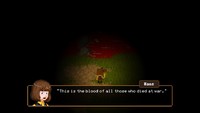|
|

|
PLATFORM
|
PC
|
PUZZLES
|

|
INTERACTION
|

|
ORIGINALITY
|

|
STORY
|

|
MUSIC & SOUND
|

|
VISUALS
|

|
CHALLENGE
|
Moderate
|
COMPLETION TIME
|
Less than 20 Hours
|
|
OVERALL

|
+ Castle Tenebre is appropriately spooky
+ Strong audio and character design
- Some familiar puzzles
- The story falls flat near the end
|
Click here for scoring definitions
|
|
|
There's something to be said for a short, focused game that gets in, says what it wants to say, and passes into the night. Not every story is suited for an 80-hour epic; by the same token, one that ends before fully exploring its premise can leave players unsatisfied. Baroque Decay's first game, The Count Lucanor, is a prime example of this diabolical balancing act. As a Gothic mystery, it lives and dies based on how it manages tension across its 5-10 hour playtime. It uses darkness, uncertain allies, and alienating environments to transport the player to an elevated state where shadows kill and every scrap of text promises deep, aristocratic depravity.
Eventually, something will give: the player becomes too scared to continue, too fed up to subsist on crumbs, or — hopefully — the story's tensions are resolved. The Count Lucanor plays this devil's game with a deft hand, but is ultimately too tricky for its own good. The grim fairy tale builds a compelling web of relationships in a short time before invalidating much of it with a twist in the final act. After the shadow play is revealed as a sham, reflecting on the experience is a bit like walking through a haunted house with the lights turned on: fun enough in a technical sense, but not as mysterious as it could have been.
The Count Lucanor is the story of Hans, a precocious boy who runs away from home because his mother is poor. He's not that great a kid, so it's no great shame when he finds himself chased by nightmarish blood animals and trapped inside a castle belonging to the wealthy Count Lucanor. Since Hans is a ten-year-old child, in the vein of Sarah from Labyrinth or The Wizard of Oz's Dorothy Gale, he doesn't have many survival skills. Facing threats head-on is a quick way to become wormfood. Or goatfood. Combat, such as it is, consists of placing candles to dispel the darkness so its dangers can be avoided. Hans can run from danger, hide under tables, and use environmental features like barrels to keep trouble at bay, but he is not a warrior.
 What mischief awaits in the courtyard?
What mischief awaits in the courtyard?
|
|
Hans isn't an especially fast walker either. His slow, crunchy steps add to the tension of being alone in a spooky castle and build the horror of being chased by its servants. Many enemies prey on Hans's limited mobility with attacks that draw him toward them. These dangerous attacks are tractor beam nightmares that end tangled in sweaty bed sheets. Hans isn't an especially hardy child, so being trapped in the corner by a pair of servants tends to simultaneously underscore their sinister, unstoppable nature and result in being juggled to death. There's probably a lesson in there about how avoiding the enemies entirely is the smart play, but the narrow hallways can make this a challenge.
Whether it's earned through ignorance or used as a tool for exploration, death is common. Aside from the castle's servants, Hans must contend with dangerous puzzles. Most of them are familiar variations on pushing blocks, flipping switches, and avoiding stationary traps while inhuman beasts get ever closer. Others involve classic adventure game fare such as locating items and using them in novel ways. When life gives you a handful of corn and a bucket of blood, maybe lemonade isn't the answer. Surviving the castle's dangers is made more aggravating by having to pay in-game currency to save. Even frequent savers will be rolling in gold coins by the end, but early puzzles that depend on precise timing or positioning are made more stressful when limited saves are paired with Hans's echoing, leaden tread.
The Count Lucanor's greatest strength is its atmosphere. Screams and unsettling, unidentified sounds lurk throughout the score and strike during tense scenes. When J.S. Bach chiptunes aren't impressing a sense of fallen grandeur on the scene, artfully composed silence hammers home the pathos of a rotten-but-plucky child caught in situations out of his control. The audio is matched by the nostalgic castle design and character quirks. The visual aesthetic mixes anime-style portraits and cutscenes with blocky characters and maps. The snappy script contains the universal language of fairy tales, but still has enough dark humor and warmth to encourage connection with the characters. Although a twist in the endgame invalidates a lot of the character development, their core elements remain appealing in spite of how they're used across different story paths.
 Why can't it ever be raspberry jam?
Why can't it ever be raspberry jam?
|
|
Depending on choices made near the end of the game and how certain puzzles are handled, Hans's story can end in multiple ways. Since not all of these endings reveal the central mystery, unlocking all of them feels more necessary than other games with multiple endings. Much like reading a Choose Your Own Adventure book and throwing it out after reaching the first ending, The Count Lucanor suffers if constrained to a single end. Helpfully, all of the endings can be unlocked from a single playthrough.
The Count Lucanor covers a lot of material for its brevity. Experienced puzzlers may not appreciate the familiar nature of the puzzles, even with the novelty of the light and stealth systems to modify them. However, Hans's curious world is a memorable place, lousy with charming quirks. Hopefully, Baroque Decay will continue to explore the ground broken by The Count Lucanor in future projects. There's nothing else quite like it.
Review Archives
|









